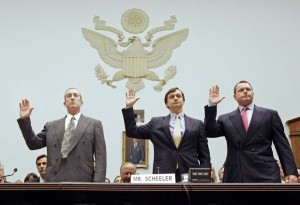Clemens’ Mistrial is Perfect Ending to Baseball’s Steroid Era 9
Given that the “Steroid Era” in baseball has been built on a series of lies, accusations and uncertainties, it seems almost normal for baseball’s darkest era to come to an end with a mistrial in a federal courtroom that accomplished nothing and left as many questions as answers.
Ever since baseballs started flying out of stadiums at uncanny rates beginning in the early 1990s, the game of baseball has been in a civil war between those who believe in preserving the history and sanctity of the sport and those who saw the opportunity for greater success through artificial means.
This battle has left baseball with nearly two decades of inflated statistics and history that no one really knows what to do with.
Baseball purists have always pointed to the purity of statistics as being one of the components that make baseball special. For generations they contended that you could directly compare the statistics of players like Joe DiMaggio, Tris Speaker and Lou Gehrig with Hank Aaron, Willie Mays and Sandy Koufax to legitimately determine the greatest players of all-time.
Now in reality that argument is unsupportable as each era has its own nuances that make it difficult to compare with other generations.
Frank “Home Run” Baker earned his nickname by leading the American League in home runs four consecutive years between 1911 and 1914. During those four seasons, he blasted a combined total of 42 home runs, including 9 to lead the league in 1914. Yes, NINE! He finished his 13-year career with 96 home runs and 103 triples.
Just a few years later, a giant lefthander pitcher named George Herman “Babe” Ruth switched from being one of the American League’s most dominant pitchers to being its greatest slugger. He led the AL with 11 home runs in just 95 games in 1918 and in his first full season playing in the field in 1919 set a new single season record with 29 home runs. He hit 54 home runs in 1920 and 59 the following year and in 1921 became MLB’s career a home run leader, a distinction he would hold until 1974. Read the rest of this entry →




